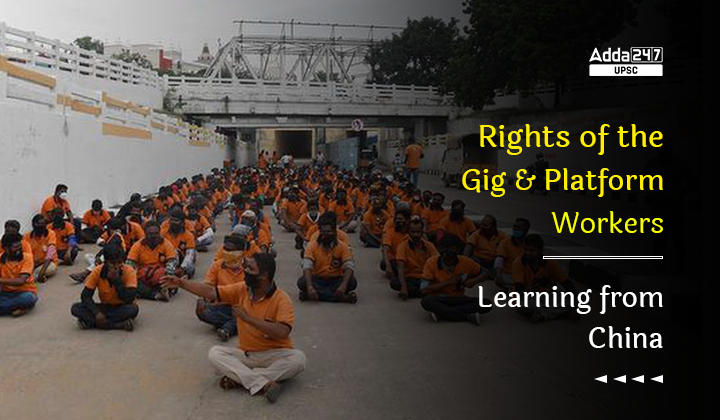Table of Contents
Gig and Platform Workers’ Rights UPSC Relevance
The article on Gig and Platform Workers’ Rights explains how the Indian public need to be more informed about the plight of gig workers, taking a leaf out of China’s experience with the same.
Gig and Platform Workers’ Rights is also important for UPSC Prelims 2023 and UPSC Mains Exam (GS Paper 2- Governance Issues and GS Paper 3- Various Aspects of Indian Economy and Issues related to labour force in India).
Gig and Platform Workers’ Rights in News
- Recently, Foodtech delivery platform Swiggy announced that it was laying off 380 employees due to challenging macroeconomic conditions.
PIL in SC on Platform Workers’ Rights
- PIL for Gig Workers: On September 20, 2021, the Indian Federation of App-based Transport Workers, on behalf of gig workers, filed a public interest litigation in the Supreme Court demanding that the Union government provide succour to workers affected by the pandemic.
- Content of PIL: The PIL petition has asked for ‘gig workers’ and ‘platform workers’ to be declared as ‘unorganised workers’ so they come under the purview of the Unorganised Workers Social Security Act, 2008.
- In short, the petition demands social security benefits from food delivery platforms such as Zomato and Swiggy and taxi aggregator apps such as Ola and Uber.
MAARG Portal- National Mentorship Platform by Start-up India
Chinese experience of Gig Workers
- Back in 2021, Owing to public pressure, two of china’s food delivery platforms, Meituan and Ele.me, committed to end the practice of forcing workers to register as ‘independent businesses’.
- This provision helped these platforms evade responsibilities as employers.
- Both platforms run a duopoly in the sector, capturing over 90% of the market share, and employ millions of gig workers.
- In a notice to labour aggregator partners, Meituan said it prohibited signing on delivery workers “through deceptive or coercive means”.
How COVID helped Delivery Workers?
- Increased Visibility: Through 2020, a trend that spanned China, India, the U.S. and Europe saw ‘invisible workers’ being propelled to ‘frontline workers’.
- Chinese Example: In China, this was especially the case in Wuhan, the pandemic’s epicentre, where there was a clear transition of social discourse in favour of delivery workers.
- People’s Daily , the largest state-affiliated daily in China, responded to public sentiment by ranking delivery work among the top 10 occupations.
Role of Media in Highlighting Concerns of Platform workers
- In the fall of 2020, Renwu, a monthly Chinese magazine, took an exhaustive look at the plight of delivery workers across the two food delivery platforms.
- The Renwu piece highlighted how delivery workers were trapped in a “sophisticated labour control system” that they had unwittingly downloaded onto their phones.
- The algorithm that is put in place by platforms is designed to create animosity between app users and workers, where the platform inherently shifts the pressure of receiving orders and maintaining smooth flow of deliveries onto the workers.
Delivery Workers in the Indian context
- The situation is vastly different in India when compared to other economies like USA and China. Any reform in this sector is led wholly by delivery workers, not the public.
- Protest by Workers: For 27 days in 2020, close to 3,000 delivery workers from Swiggy went on strike in Hyderabad to protest the slash in remuneration from ₹35 to ₹15 per order.
- The strikes disbanded only after the Joint Commissioner of the Labour Department called a hearing with the platform’s operations manager and the workers’ union.
- It was the first time in India that such a negotiation was taking place, that too on the street.
- Case of Zomato: In the lead up to Zomato’s July IPO, several anonymous Twitter accounts set up by delivery workers called customers’ attention to what they deem as “exploitative practices” employed by platforms.
- PIL in Supreme Court: The PIL in the Supreme Court is another major step in this regard.
India Needs Small Enterprises For Green Economy, The Hindu Editorial Analysis
Way Forward
- Learning from China: The biggest lesson from China is the swell of public opinion that has partly led to government regulation and change in company policy.
- Learning from USA: In the U.S., a gig workers collective has urged customers to delete the Instacart app as a show of solidarity until demands for better working conditions are met.
- Lessons for India: Indians could make an effort to be better informed about the way platforms work by seeking out delivery workers and asking about their work conditions and the pressures they face.
- We will then be aware of the price that a person, who we only see as a miniature bike on our apps, pays for our convenience.
Gig and Platform Workers FAQs
- Who are Gig Workers?
Ans. Gig workers are those workers who are engaged in livelihoods outside the traditional employer-employee arrangement.
- The ‘India’s Booming Gig and Platform Economy’ was released by which Body?
Ans. NITI Aayog has launched a report titled ‘India’s Booming Gig and Platform Economy’ on the gig–platform economy in India.
- Delivery Partners of Swiggy and Zomato are example of which type of Workers?
Ans. Delivery Partners of Swiggy and Zomato are example of gig and platform workers.
NITI Aayog Report on India’s Gig and Platform Economy



 TSPSC Group 1 Question Paper 2024, Downl...
TSPSC Group 1 Question Paper 2024, Downl...
 TSPSC Group 1 Answer key 2024 Out, Downl...
TSPSC Group 1 Answer key 2024 Out, Downl...
 UPSC Prelims 2024 Question Paper, Downlo...
UPSC Prelims 2024 Question Paper, Downlo...




